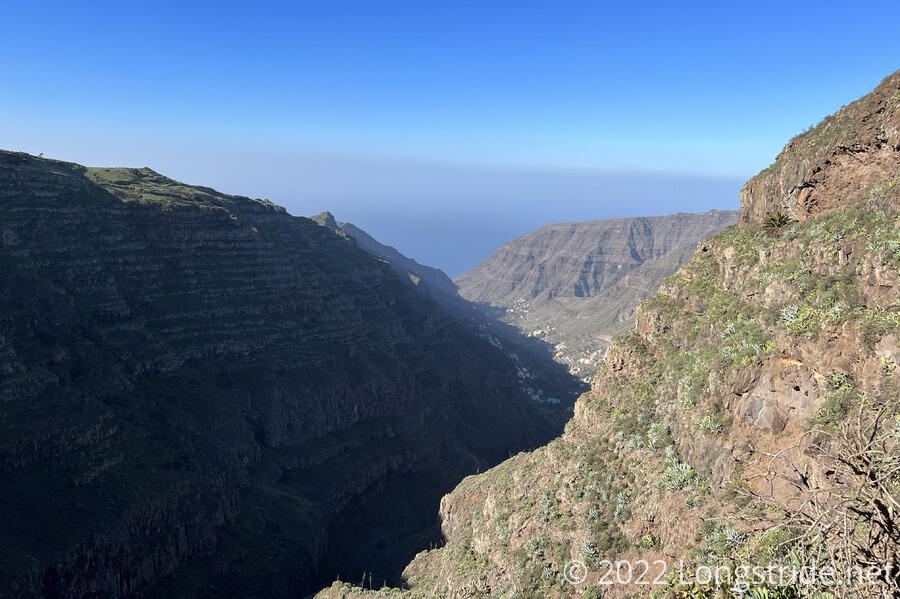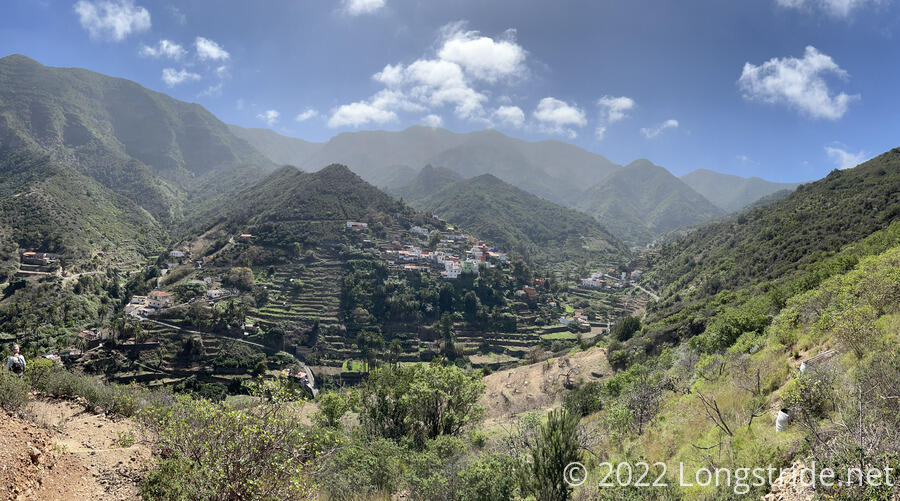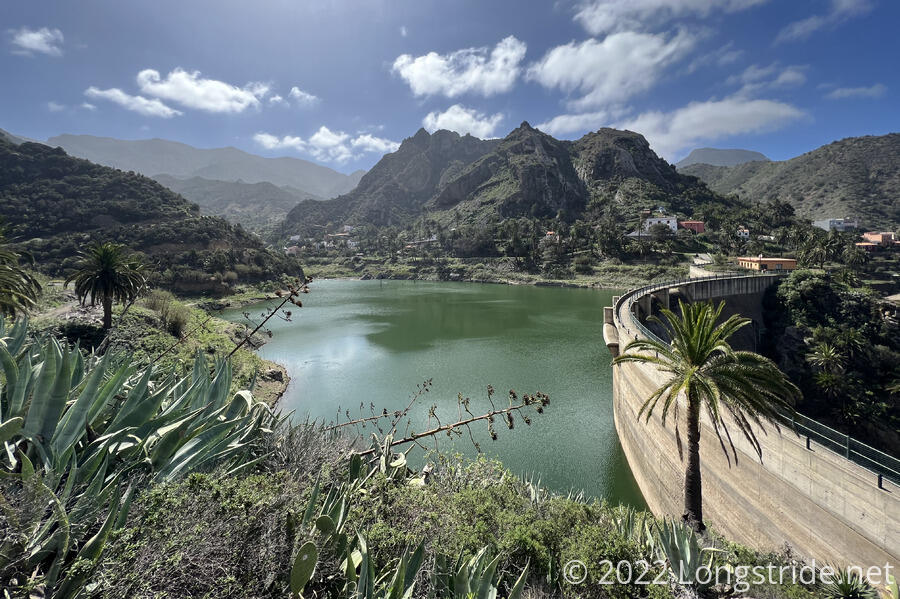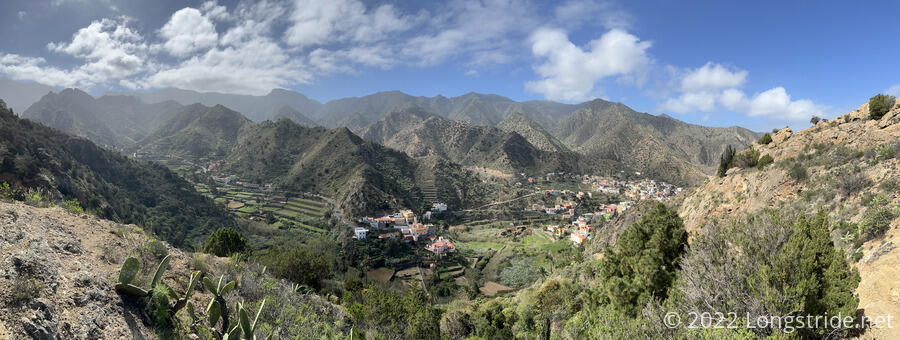Today, we hiked from Chipude to the Playa de Vallehermoso, finishing our two day hike of La Gomera, and completing our sixth Canary Island.
Leaving Chipude around 9:30, we spent roughly the next half hour walking through neighboring towns. Once we got away from the towns, the beautiful landscape of La Gomera returned. One of the first views we got was to Valle Gran Rey, where we’d planned on staying last night.
As yesterday, there were no small number of farming terraces cut into the mountains. At the head of the valley leading to Valley Gran Rey, terraces ran right up to a sheer drop-off into the valley.
Later, the trail took us through a nicely shaded “cloud forest”. During wetter parts of the year, the forest here is often in the clouds, and is adapted for that. Today, though, the clouds were above the forest.
After we left the forest, we had a bit of a surprise when a troop of ten or fifteen Spanish soldiers hiked past us, most with machine guns, though fortunately there was enough space on the side of the trail for us to let them go by.
Approaching a town, the trail temporarily became a bit inhospitable, with a steep rocky tread, a rusty barb wire fence on the left, and slightly overgrown plants on the right. But even that eventually gave way to large valleys with terraces.
We stopped for a short snack break at a nice covered picnic area in Rosa de las Piedras (complete with grills for cooking). Following a small road out of town, we curved around a water reservoir. We were a little disappointed that the trail did not actually go across the top of the reservoir’s dam, like it did in Ayaguares on Gran Canaria. (Besides just generally being cooler, that might also have been a little shorter.)
Past the reservoir, the trail climbed up a steep hill. Log steps had been installed to stabilize the hillside and make it a little easier to hike up, but the trail had eroded very significantly since the steps were installed, and some of them were hanging by their supports in the air, almost making it more dangerous and difficult than if they weren’t there at all.
Yesterday, after nearly 2000 m (6400 ft) of uphill, we reached the high point of La Gomera. Today, we were hiking back towards the ocean, and we were ready for a mostly downhill day. Which we got. Still, though, we had a surprising amount of uphill hiking today, in between several relatively steep descents, and our common complaint today when hiking uphill was, “this downhill is broken”.
We eventually made our way to Vallehermoso, with the trail taking us into a large square in the middle of town, with a supermarket and several restaurants. Not wanting to spend too much time in town just yet, we opted for ice cream and sodas from the supermarket, and sat down at the outdoor seating for a restaurant only open on two days a week (Tuesday and Saturday; it being mid-afternoon on a Saturday, they were closed for siesta).
From Vallehermoso, we followed roads leading away from town, which turned onto a nice grassy lane, and then across an old rickety bridge to what was once a farm terrace, which led us further away from town and towards the ocean.
Across the valley, terraces ran impressively far up the valley wall, and we gradually descended towards the ocean. Eventually, the trail gave out and joined the road to the Playa de Vallehermoso. After a few minutes along the road, we reached the beach, and the end of the GR131 on La Gomera.
It was a small beach, but impressive in its own right. The beach shore was set back a few hundred feet from the ocean, which served to funnel the waves, causing them to crash roughly as they came to the shore, splashing quite high against the rocks. There wasn’t a clear waterline per se, the water level pulsed up and down (and in and out) depending on the timing of the incoming waves.
The beach itself had no sand, only a layer of smooth stones that quickly gave way to a rocky jumble. An area maybe a dozen feet wide had been mostly cleared of rocks so that it was possible to walk to the water. But given the roughness of the waves and the relative unpredictability of how deep the water was going to be at any time, I can’t imagine many people would actually want to swim here.
Nearby was the Castillo Del Mar, an old castle on the shore. A stone walkway allowed access, and we probably would have visited it if we had a bit more time available.
We called a taxi to take us the couple of miles back to Vallehermoso. (The driver probably ripped us off; he didn’t turn on the taxi meter, charged us way more than we expected, refused to take credit cards, and seemed very nervous while doing so.) We went to one of the restaurants, a burger joint, and got hamburgers to celebrate the completion of La Gomera.
After we finished our burgers, we walked back to the bus station, getting there about half an hour early. Our bus to San Sebastián was already there, waiting for us.
While we were waiting for the bus to leave, I noticed the driver carrying several large bottles of water to the bus. It seemed odd, but I didn’t think much more of it at the time.
This was going to be a long bus ride, almost an hour, to take us to the other side of the island. (Naturally, via curvy mountain roads, because the only islands actually flat enough to have straight roads have been Lanzarote and Fuerteventura.) Along the way, we got a decent view of the summit of El Teide on Tenerife, floating atop a sea of clouds.
When the bus stopped in the town Hermigua, though, we didn’t go anywhere, and after several minutes, we began to suspect something was wrong with the bus. This was confirmed when the bus driver got off the bus, and then got back on with his cell phone and started to count passengers.
The bus had apparently broken down, and the driver had called to arrange taxis to take all of the passengers on to San Sebastián. As the first taxi arrived and roughly a third of the bus piled in, the bus driver was pouring water from an 8 L water jug (via a much smaller bottle, spilling a lot of water on the ground) into (what I presumed was) the coolant tank for the engine. I guess there was a coolant leak that the driver knew about, and it was a gamble as to whether the bus would successfully make the trip.
Our taxi passed a few bus stations with many people waiting. I felt bad for them, because they had no way of knowing why the bus was late (or that, very possibly, the bus was not even coming at all).
Now past sunset, as we approached San Sebastián, two very bright lights stood out. As we got closer, it became clear they were lights for illuminating a soccer stadium. Also visible were a string of lights illuminating a cruse ship docked in the port.
We arrived at the bus station maybe twenty minutes later than expected. We quickly made a stop at a grocery store for water and snacks tonight and tomorrow, and checked back in to our hotel from two nights ago.
Tomorrow: A (hopefully) relaxed travel day, as we make our way by ferry to La Palma, our penultimate island.





